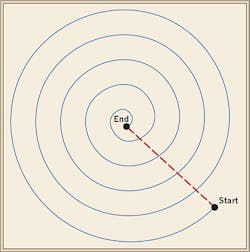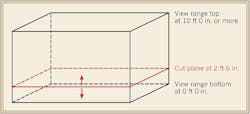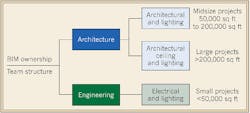Although building information modeling (BIM) technically originated in the late 1980s, true implementation of this technology didn’t start to gain real traction until much later. We’ve come a long way since the early days of BIM adoption on the design delivery front, but there’s always room to grow. Today, we are beginning to understand how BIM and digitally informed design can significantly modify how we work. However, while there are many obvious advantages to these new work tools and processes, some distinct disadvantages still exist. This article will explore the impact of digitally informed lighting design today as well as look at the trends of tomorrow.
BIM and the design process
Design is an iterative process. The more a design is reviewed and revised, the more refined it becomes. As soon as we create a model of our design, the iterative cycle begins, as is illustrated by the spiral in Fig. 1. The line, intentionally dashed, represents the shortest — yet most difficult — route to a solution.
BIM offers the ability to facilitate iteration dynamically. Designers can see changes, make choices, and finalize decisions quickly and earlier in the process. This is a departure from the past, where numerous drawings were marked up to reflect even a single change. But as the design industry has evolved from hand drafting to two-dimensional computer-aided drafting (CAD) to three-dimensional BIM, it is interesting to explore what we have gained — and perhaps lost — along the way.
“There was a transition moving from hand drafting to CAD, but we viewed that as a productivity increase and time saver in the long run,” notes Steve Hefferan, principal of Hefferan Partnership Lighting Design (HPLD) in Boulder, Colo. “The chemistry of the team is, as it always was, vital to creating a successful lighting design.”
Karen Murphy, senior lighting designer at HDR Architecture, believes the software is a great tool for the lighting designer and has helped advance the global industry’s capabilities. BIM is particularly advantageous for contractors, according to Jason Massoth, senior project manager at MC Dean, Fort Belvoir, Va. “Typically, before BIM was used on projects, conflicts resulted in re-mobilization and change order costs to the owner,” he explains.
With BIM, Massoth adds, the building is modeled, and problems are worked out prior to constructing it in the field. Yet, while software does facilitate design, Murphy cautions the downside is that software makes the design process look almost too easy. Software cannot and does not replace the knowledge of a professional, she argues, as it cannot understand the nuances associated with lighting strategies. Skillful and talented professionals are needed to make decisions. BIM does not replace the value a professional must bring to a project to ensure its success. Additionally, increased costs, layered with the added complexity of the software, training, and hardware, can present a disadvantage.
Strategies for effective BIM use
Successfully using BIM includes exploration of documentation and modeling responsibilities. BIM provides real-time coordination between disciplines, given the fact that even the slightest change can have multiple impacts. For example, a modification to a reflected ceiling plan (RCP) flows to all associated plan, section, schedule, and detail views. Designers can capitalize on the database functionality of BIM, automating take-off and energy assessment tasks, and even providing rendering tools for model visualization — tasks that previously were more time and labor intensive.
According to Paul Daniel, senior lighting designer with HDR Architecture, Princeton, N.J., designers need to remember there is a learning curve associated with using this software, and it takes time to master. He recommends investigating the many training mechanisms available commercially from software vendors, along with a few lighting design specific tools.
When setting up working views, it is typically desirable to see ceiling, equipment, furniture, and floor plans achieved by a cut plane at task level — for example, at 2 ft, 6 in. above finished floor (AFF) with the bottom of the view range at zero and the top at 10 ft (Fig. 2).
Two types of labeling parameters are available for fixture elements. Instance parameters are unique to one device, such as a circuit number. Type parameters are global; one change updates all associated devices. For example, a fixture type change within a fixture schedule simultaneously changes all associated devices throughout the model.
Two types of lighting fixture placement configurations are offered. Level-based fixtures provide an independent component, allowing changes such as the height or location, independent of the architecture. Face-based fixtures are hosted to architecture. For example, when a ceiling is moved, the associated fixtures move; when a wall is deleted, the associated fixtures are deleted.
With so much digital content accessible to various disciplines, trust is imperative for successful project delivery, as is an initial understanding of the BIM delivery ownership and team structure. Project size is one criterion that can be used successfully to structure the model (Fig. 3). For example:
• For mid-size to large projects, lighting devices reside within the architecture model independent of the engineering model.
• For large projects, architectural ceilings and lighting devices reside in one model alone for computing efficiency.
• For small projects, the lighting devices reside within the engineering model, where coordination of lighting and architecture is more difficult due to the separate models, yet manageable.
While useful for portions of a project, some software programs are not appropriate at all phases, particularly if lighting design decisions are being pushed forward well before other crucial design decisions have been finalized, according to HPLD’s Hefferan. Tom Lyman, director of lighting design at HDR Architecture, shares this view. “BIM does not necessarily replace the idea of developing concept sketches and relaying them to people,” he notes.
This is particularly true for daylighting design. Clarence Waters, a professor of architectural engineering at the Durham School of Architectural Engineering and Construction University of Nebraska-Lincoln (Omaha Campus), emphasizes that daylighting must be considered before lines are placed on paper or into BIM. “It needs to be considered from the very, very concept,” he says.
One way to provide daylighting analysis earlier is by using Google SketchUp and OpenStudio, recommends Rob Guglielmetti, daylighting engineer at the National Renewable Energy Laboratory (NREL), Golden, Colo. Guglielmetti reports that very little modeling time is required to rapidly build up a series of results from different energy conservation measures and actually see integrated results. NREL’s Jennifer Scheib, lighting engineer, offers the following analogy: You need both the sequence of operations as well as the circuiting diagram and RCP. The installer relies on the plans and the contractor to purchase equipment. However, in terms of accepting the solution and pushing a solution in operating mode, that sequence of operations is extremely critical. There is overlap and different approaches to lighting design but typically concept narratives, discussions, and sketches are considered, daylighting and electric lighting software is used, and then BIM is implemented.
The future of BIM in lighting design
With the integrated approach BIM provides, intelligent content is readily available to the design team, which can be very successfully employed under the right circumstances. Cost savings for contractor, design-build, and A/E firms are easily realized. BIM combines documentation, coordination, and scheduling tools in one platform.
When all disciplines share devices, courtesy is essential, or problems will abound. Jon Brooks, principal of
Architectural Engineering Design Group, Inc., Denver, recommends that firms use state-of-the-art computers. This is because older computer models that may run CAD may not be able to run BIM programs effectively. Additionally, in the short-term, there are training costs associated with BIM with a dearth of electrical specific trainings available.
Blythe von Reckers, outside specification sales with Pacific Lighting Systems, Seattle, receives requests for BIM devices for all of the fixtures her firm represents. “Lighting manufacturers’ BIM devices need to be simple, reducing complications while increasing digital libraries for lighting representatives and designers,” she says. “Development of lean BIM content, appropriate for efficient implementation, is needed.”
When all disciplines share devices, it creates new ways of approaching lighting design as AEDG’s Brooks points out. He sees BIM as much more than a design-draft; the architect or engineer is actually drawing as they are designing.
At the University of Nebraska, architectural engineering is a new program that has stemmed from such industry demands. Professor Waters says that what began as hand drafting and then evolved to CAD has now evolved to teaching lighting software tools and BIM.
Another big revolution is solid-state lighting (SSL) technology and all the different types of product and product cycles, according to Hefferan of HPLD. With shrinking project budgets and schedules paired with changes in technology and energy use policies, firms are looking for efficiencies while maintaining a high level of quality. Appropriate use of these various resources and BIM tools by the lighting design professional is paramount to provide the best design software, at the best time, in the best manner, so as to best serve the client.
Bates and Meliani are electrical engineers with HDR Architecture, Alexandria, Va. They can be reached at [email protected] and [email protected].






